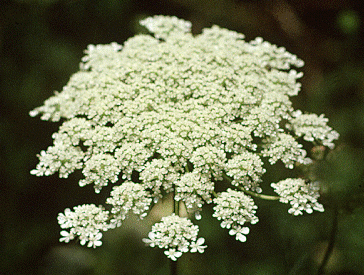
 Queen Anne's Lace is the wild progenitor of our carrot. Although native to the Old World, these white lacy umbels are a familiar sight in the United States and Canada
Queen Anne's Lace is the wild progenitor of our carrot. Although native to the Old World, these white lacy umbels are a familiar sight in the United States and CanadaThis plant is a biennial which grows, in its second year, from a taproot (the carrot) to a height of two to four feet. The stems are erect and branched; both stems and leaves are covered with short coarse hairs.
The leaves are very finely divided; the botanical term is tri-pinnate. When a leaf is composed of a number of lateral leaflets, it is said to be pinnate or feather-like; and when these lateral divisions are themselves pinnated, it is said to be bi-pinnate, or twice-feathered. The leaves of this plant are like that but some of the lower leaves are still more divided and become tri-pinnate. The lower leaves are considerably larger than the upper ones, and their arrangement on the main stem is alternate. All of these leaves embrace the stem with a sheathing base.
The attractive two- to four-inch "flower" is actually a compound inflorescence made up of many small flowers. The umbels of the flowers are terminal and composed of many rays. The flowers themselves are very small, but from their whiteness and number, present a very conspicuous appearance. The central flower of each umbel is often purple.
During the flowering period the head is nearly flat or slightly convex, but as the seeds ripen the form becomes very cup-like; hence one of the popular names for this plant is "bird's nest." The seeds are covered with numerous little bristles arranged in five rows.
Wild carrot is edible when young but the root (especially the center) soon gets tough. It is yellowish in color, spindle-shaped, slender, firm and woody; a pernicious weed in some areas.
